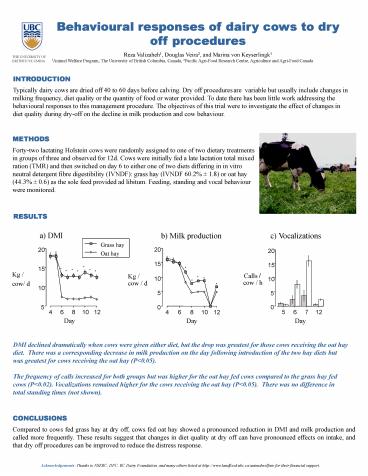Behavioural responses of dairy cows to dry off procedures PowerPoint PPT Presentation
1 / 1
Title: Behavioural responses of dairy cows to dry off procedures
1
Behavioural responses of dairy cows to dry off
procedures Reza Valizaheh1, Douglas Veira2, and
Marina von Keyserlingk1 1Animal Welfare Program,
The University of British Columbia, Canada,
2Pacific Agri-Food Research Centre, Agriculture
and Agri-Food Canada
INTRODUCTION Typically dairy cows are dried off
40 to 60 days before calving. Dry off procedures
are variable but usually include changes in
milking frequency, diet quality or the quantity
of food or water provided. To date there has been
little work addressing the behavioural responses
to this management procedure. The objectives of
this trial were to investigate the effect of
changes in diet quality during dry-off on the
decline in milk production and cow behaviour.
METHODS Forty-two lactating Holstein cows were
randomly assigned to one of two dietary
treatments in groups of three and observed for
12d. Cows were initially fed a late lactation
total mixed ration (TMR) and then switched on day
6 to either one of two diets differing in in
vitro neutral detergent fibre digestibility
(IVNDF) grass hay (IVNDF 60.2 1.8) or oat hay
(44.3 0.6) as the sole feed provided ad
libitum. Feeding, standing and vocal behaviour
were monitored.
RESULTS
b) Milk production
c) Vocalizations
Calls
/
cow / h
Day
Day
DMI declined dramatically when cows were given
either diet, but the drop was greatest for those
cows receiving the oat hay diet. There was a
corresponding decrease in milk production on the
day following introduction of the two hay diets
but was greatest for cows receiving the oat hay
(Plt0.05). The frequency of calls increased for
both groups but was higher for the oat hay fed
cows compared to the grass hay fed cows (Plt0.02).
Vocalizations remained higher for the cows
receiving the oat hay (Plt0.05). There was no
difference in total standing times (not shown).
CONCLUSIONS Compared to cows fed grass hay at
dry off, cows fed oat hay showed a pronounced
reduction in DMI and milk production and called
more frequently. These results suggest that
changes in diet quality at dry off can have
pronounced effects on intake, and that dry off
procedures can be improved to reduce the distress
response.
Acknowledgements Thanks to NSERC, DFC, BC Dairy
Foundation, and many others listed at
http//www.landfood.ubc.ca/animalwelfare for
their financial support.

